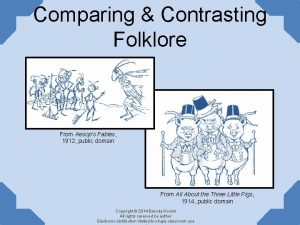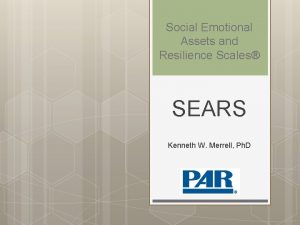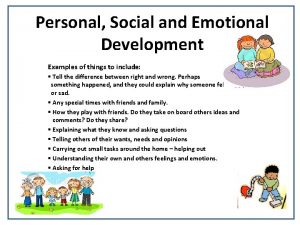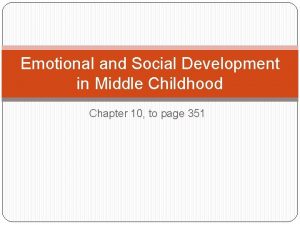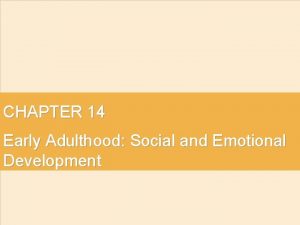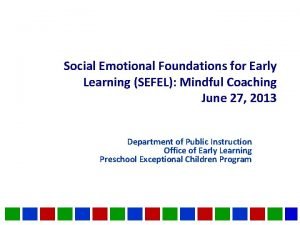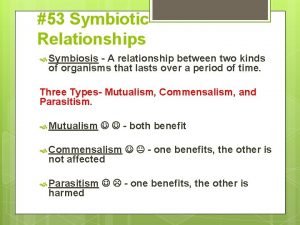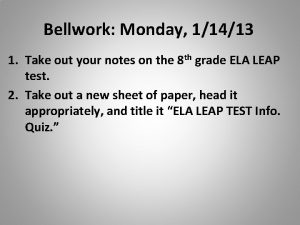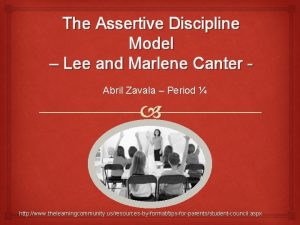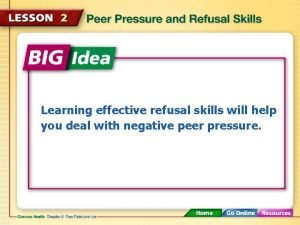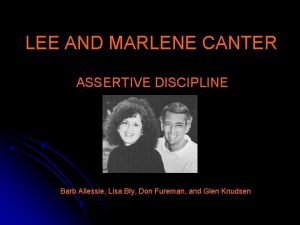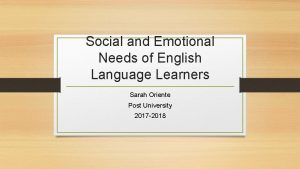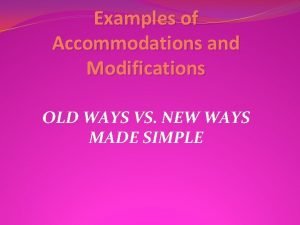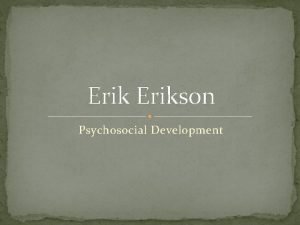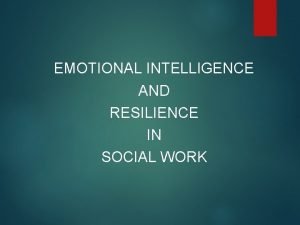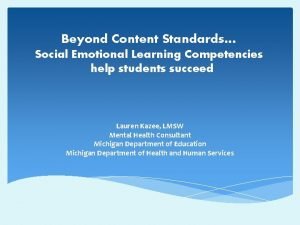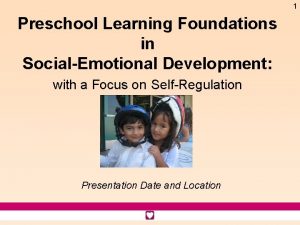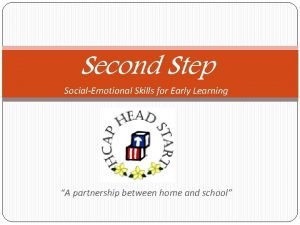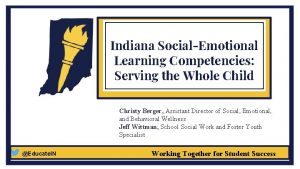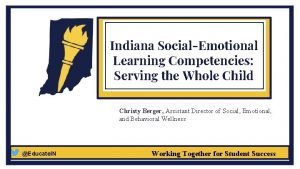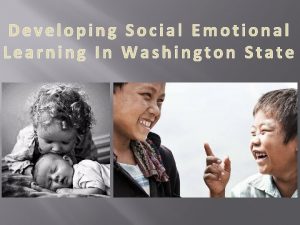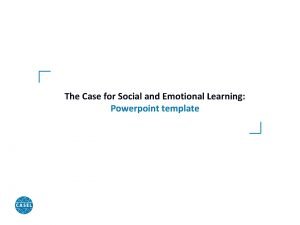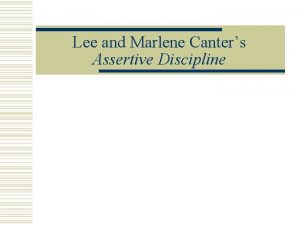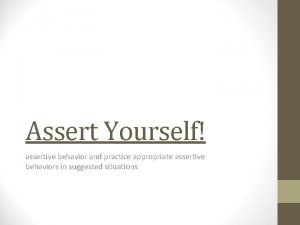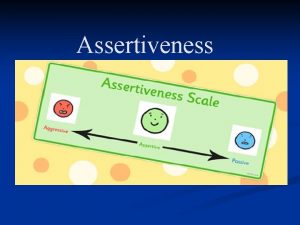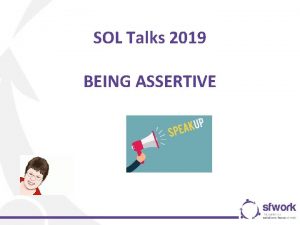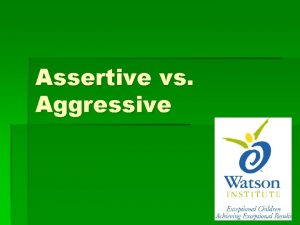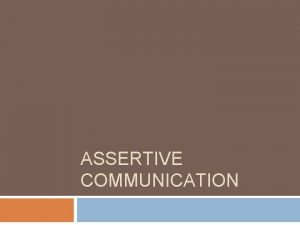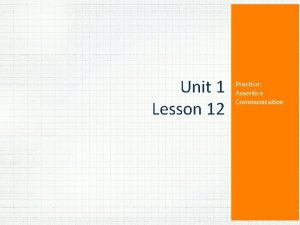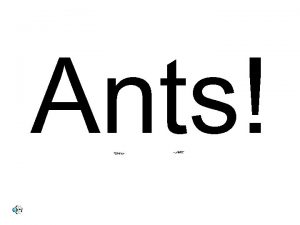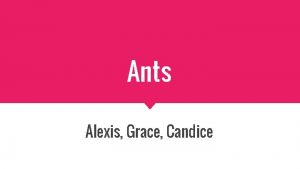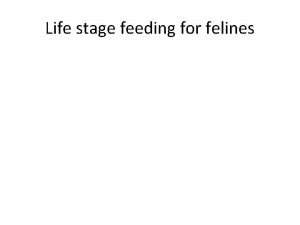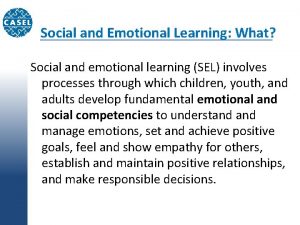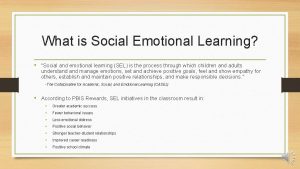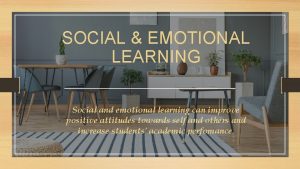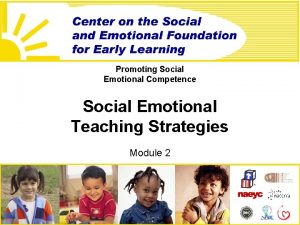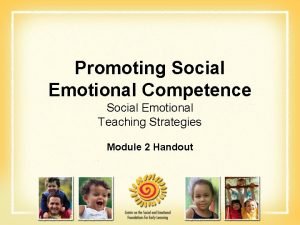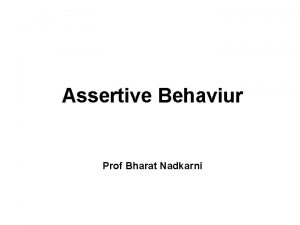Assertive Ants and Friendly Felines Implementing Social Emotional







































- Slides: 39

Assertive Ants and Friendly Felines: Implementing Social Emotional Learning in the Classroom Hannah Knipp, LMSW: SEL Coordinator Amanda Schroeder, LPC-S, NCC: President & CEO

Friendly Feline and Critical Cat 2

Self-Talk Lesson Broken Down K-2 3 3 -4 • Storytelling • Review Game • Introduce Concept • Practice (Act out scenario) • Practice (Writing activity) • Reflection • Extension- Draw

Reflection • What feelings did you have in the beginning, middle, and end of the activity? • How do you anticipate elementary age students would react to this lesson? • How could this lesson be extended throughout the school day? 4

Objectives Participants will participate in two interactive Social Emotional Learning (SEL) lesson plans and apply experience to their unique position. Participants will gain background knowledge of the SEL Coordinator role and SEL learning in general. Participants will evaluate the readiness of their placement schools/affiliates to implement SEL practices and anticipate potential barriers and gateways. Participants will create 1 -3 concrete action steps they can take to implement SEL within their unique position. 5

Timeline Who’s Here? 10 minutes- Self-Talk Lesson and Process 20 minutes- The SEL Coordinator Position 10 minutes- Where Do You Stand Lesson and Process 15 minutes- Getting Started 20 minutes- Action Planning and Q & A 6

SEL Coordinator- History and Background ● ● 7 Why Social Emotional Learning (SEL)? Research shows that embedding SEL strategies within school curricula promotes improved behavior, academic performance, and social skills It is estimated that for every $1 invested in SEL prevention strategies, the community saves $11 in costs related to substance abuse, youth delinquency, juvenile crime, and more. Teaching to the test, but what are we leaving out? Equity- teaching SEL to disadvantaged youth is a powerful tool for enhancing equity.

SEL Coordinator- History and Background CIS, Bricolage Academy, and NOLA Charter Schools 8

What It Takes ● ● ● ● 9 Culture of SEL Communication to all stakeholders Create buy-in from all staff and caregivers Ongoing professional development of staff Consistency Accountability Observations Data- RESULTS!!

SEL Coordinator vs. Teacher Implementation 10

How to Make it Work for Your School ● K-4/High School: SEL Coordinator implementing weekly lessons inside each classroom and provides Tier 2 SEL supports to students. ● K-8: SEL Coordinator implementing quarterly lessons in each class. Creates curriculum, observes classes bi-weekly, coaches teachers and staff. Creates Tier 1’s to coincide with classroom lesson topics, and provides Tier 2 and Tier 3 SEL supports to students. 11

Funding Opportunities: Get Creative ● Office of Juvenile Justice and Delinquency Prevention ● United Way ● Center for Disease Control and Health and Human Services Grants ● IDEA-B ● ESSA ○ Title I funding through “Schoolwide Programming”. ○ Title I “Improving the Academic Achievement of the Disadvantaged” ○ Title IV “Student Supports Enrichment Grant” (new large block grant) ● Local Foundations ● Donors Choose- curriculum 12

Boxed SEL vs. SEL Creation Boxed SEL Programs: ● Second Step, Paths, SSIS, 4 R’s, Caring School Community ● Evidence Based and proven curricula ● Casel Guide to SEL Programs Unique SEL Creation: ● ● ● 13 Culturally Competent Adjust for teacher ease, boxed overly scripted Unique for your school population Flexibility Based on need

SEL Coordinator- Continuum of Services • Tier 1 Services • • • 14 Bi-weekly class Sexual health classes (3 rd and 4 th only) Yoga/Mindfulness Sessions Lunch Bunch sign ups Self-Referrals No Place for Hate Program Bullying Prevention Program Weekly Emails to Staff Monthly Newsletter to Parents Bi-Monthly Roundtables for Staff Responsive SEL lessons by classroom

SEL Coordinator- Continuum of Services • Tier 2 Services • Group counseling • • • Social Skill Improvement System Journey of Hope New Kids on the Block Black Girl Blues Breaking the Boy Code • Tier 3 Services • • 15 Individual Counseling Crisis Intervention Behavior Support (FBA/BIP development) Coordination of Outside Providers

SEL Coordinator- Benefits • SEL time is non-negotiable and does not get pushed aside by competing interests • Common language across classrooms • Easily differentiated by grade • SEL becomes part of the school community and is not seen as an additional task • Behaviors can be seen as skill deficit instead of defiance- empowers teachers • Designated staff member to use as expert in the field for consultation • Creates community of caring and compassion 16

SEL Coordinator- Drawbacks • Students are better able to voice their emotional needs which can make the demand seem higher • Adults can have unrealistic expectations of student changes in short term • Maintaining professional boundaries and clientclinician relationships within role • Cost associated with adding an additional staff member 17

Important Components • Reflection, reflection • Effective feedback loops- from parent, teacher, and students • Tiers to address all levels of SEL need and concern • Homeroom teachers must be intimately involved • Balance whole-school goals with responsiveness to classroom issues (prevention + intervention) • SEL Instructor- professional boundaries, confidentiality, facilitation skills, empathy, responsiveness, communication skills, self-care 18

Program Effectiveness- 2016 -2017 • 2016 -2017 Staff Survey • • 19 Scale of 1 -5 not satisfied to highly satisfied 83% rated score of 4 or 5 (sample size= 12)

Program Effectiveness- 2016 -2017 “Having an SEL teacher to build common language among classes, and social problem solving skills made a big difference in my class this year, and in how I was able to interact and help students from other classes solve problems. ” • 2016 -2017 Student Survey • • • Average score 3. 9/5. 0 - Enjoy SEL Average score 3. 3/5. 0 - Use SEL Skills Average score 3. 8/5. 0 - Easy to Talk To SEL Coordinator “I love the SEL classes and the proactive work that you do with kids. I also think it's been really helpful to have you there when kids have a specific issue. I really appreciate your responsiveness and flexibility!” 20

Program Effectiveness- 2017 -2018 • 2017 -2018 Staff Survey • • 21 Scale of 1 -5 not satisfied to highly satisfied 94% rated score of 4 or 5 (sample size= 18)

Program Effectiveness- 2017 -2018 “I have found SEL classes with Ms. Knipp incredibly helpful throughout the whole year. She is able to teach skills that I am afraid I would not set aside time to teach on my own. She also teaches so much important language for the kids to use, as well as myself. I have had tons of parents at conferences talk about how what their child learns in SEL is even extending to their home. ” • 2016 -2017 Student Survey • • • Average score 3. 7/5. 0 - Enjoy SEL Average score 3. 1/5. 0 - Use SEL Skills Average score 3. 6/5. 0 - Easy to Talk To SEL Coordinator “It is awesome to have SEL on an ongoing basis and the kids really used the language that was provided to them. It definitely benefited the class. ” 22

Program Effectiveness- 2017 -2018 • 2017 -2018 Caregiver Survey • • 23 Scale of 1 -5 not satisfied to highly satisfied 92% rated score of 4 or 5 (sample size= 26)

Program Effectiveness- 2017 -2018 “SEL is always one of the things I mention when I talk to other parents about Bricolage! I feel its one of the most important classes they receive. My kids have internalized and practice many of the lessons etc learned form Ms. Knipp” “My child was able to verbalize key points from SEL lessons and this allowed us to continue the conversations at home. I am so grateful that this exists!” “I think your support to our kids in invaluable. I hear more about what they learn in SEL class than a lot of whatever else happens throughout the day. My only feedback is to have more. It is so important at this age. ” 24

Where Do You Stand? 25

Reflection • What topics or questions could you ask elementary age students in this activity? • How do you anticipate elementary age students would react to this lesson? • What ground rules may need to be set up in order for this activity to be successful? 26

Getting Started- SEL Competencies What are some sub skills for each category? • Self Awareness • Self Management • Relationship Skills • Social Awareness • Responsible Decision Making Learn more at the Collaborative for Academic, Social, and Emotional Learning (CASEL) https: //casel. org/ 27

Getting Started- Scope and Sequence By State: https: //casel. org/wpcontent/uploads/2017/03/K-12 -Learning-Goals-for-SEL -Feb-2017. pdf Often included in Academic Guidelines: Check out health, social studies, ELA (speaking and listening standards) School Social Workers: https: //docs. wixstatic. com/ugd/426 a 18_966 d 8 eb 4 f 4 a 9 4 f 62974304 c 077 c 1 a 619. pdf School Counselors: http: //static. pdesas. org/content/documents/asca_nati onal_standards_for_students. pdf 28

Getting Started- Conduct a Needs Assessment Interview and survey stakeholders: • Students, Families, Teachers/Staff, Community Do not assume stakeholders know what SEL is- may need to first instruct on types of skills within SEL -What SEL skills do you see your students already performing well with? -What SEL skills do they need additional practice with? -Where are students currently learning about SEL related skills? 29

Getting Started- Conduct a Needs Assessment Identify existing programs and resources -Co-curricular classes? -Integration to academic curriculum? -After school/community programs? Map out important events (testing, school programs/assemblies, community events) -Identify natural areas to promote SEL skills (exampleteaching about test anxiety during state testing; building in teamwork standards around field day) 30

Getting Started- Conduct a Needs Assessment Establish realistic goals + triage and prioritize needs • How many members are on my team? • How much time (be realistic) do we have to devote to this per week, per month, per quarter? • Do we have the parent, staff, and administration buyin we need to start this year OR should our first goal be creating buy-in? • What barriers may impede success? • How can I combat those barriers? 31

Getting Started- Conduct a Needs Assessment Establish an evaluation tool • How will I determine if my goal was met? • How will I measure success? • Examples- student pre-tests and post-tests, parent surveys, student self-report surveys, teacher/staff surveys • Timeline for completion 32

Getting Started- Topic Areas • Feelings • Conflict Resolution • Coping Skills • Diversity, Equity, Inclusion • Problem-Solving • Communication • Relationship Skills • Digital Citizenship • Sexual Health 33 • Teamwork, Collaboration • Bullying Prevention • Kindness and Empathy • Self-Talk

Getting Started- Helpful Resources • Institute for Social and • Responsive Classroom Emotional Learning • Don’t Laugh at Me • Teaching Tolerance (Operation Respect) • Rights, Respect, Responsibilities • Eliminating Bullying • Mindset for Learning • GOOGLE! • Social Skills • Common Sense Media Improvement System 34

Getting Started- Helpful Resources • • Each Kindness The Other Side Big Red Lollipop When Sophie Gets Angry This Is Our House The Sneetches How Full is Your Bucket? Leonardo and the Terrible Monster • Today I Feel Silly and Other Moods that Make My Day • Mixed Me 35 • My Three Best Friends and Me, Zulay • Those Shoes • Julia Cooke books (I Just Don’t Like the Sound of No, Soda Pop Head, etc). • Pat Thomas books (The Skin I’m In, Don’t Call Me Special) • Todd Parr books (It’s Okay to be Different, Feelings Book)

Action Planning Use the template to begin working independently, with a partner, or in small groups on setting some goals and action steps for next year Try to leave with 3 concrete goals you can implement next year (both big and small) 36

Share Out • What ideas did you come up with? • What challenges do you think you may face with this plan? • What resources or allies can you go to for support with this plan? 37

Q&A Thanks for coming! Hannah Knipp, LMSW, SEL Coordinator hannahk@cisgulfsouth. org 504 -250 -2163 Amanda Schroeder, LPC-S, NCC: President & CEO amandas@cisgulfsouth. org 38

Resources ASCA National Standards http: //static. pdesas. org/content/documents/asca_national_standards_fo r_students. pdf Aspen Institute, 2016. Sead fact sheet. https: //assets. aspeninstitute. org/content/uploads/2016/09/ncsead-factsheet. pdf Belfield et al. , 2015. The Economic Value of Social and Emotional Learning. Collaborative for Academic, Social, and Emotional Learning (CASEL) https: //casel. org/ SSWAA National Standards https: //docs. wixstatic. com/ugd/426 a 18_966 d 8 eb 4 f 4 a 94 f 62974304 c 077 c 1 a 619. pdf 39
 Venn diagram of ant and grasshopper
Venn diagram of ant and grasshopper Sears rating scale
Sears rating scale Fictional character examples
Fictional character examples Social development in middle childhood
Social development in middle childhood Middle age
Middle age Emotional development early adulthood
Emotional development early adulthood Social and emotional wellbeing framework
Social and emotional wellbeing framework Social and emotional foundations for early learning
Social and emotional foundations for early learning Socioemotional development in late adulthood
Socioemotional development in late adulthood Implementing strategies management and operations issues
Implementing strategies management and operations issues Strategic management chapter 7
Strategic management chapter 7 Chapter 7 strategic management
Chapter 7 strategic management Tripod of pricing
Tripod of pricing Designing and implementing brand architecture strategies
Designing and implementing brand architecture strategies Brand hierarchy levels
Brand hierarchy levels Crm project plan
Crm project plan Symbiotic relationship between deer and tick
Symbiotic relationship between deer and tick Matching structure with strategy
Matching structure with strategy Brand hierarchy tree
Brand hierarchy tree Ants at the olympics poem questions and answers
Ants at the olympics poem questions and answers Implementing strategies management and operations issues
Implementing strategies management and operations issues Apa itu social thinking
Apa itu social thinking Social thinking social influence social relations
Social thinking social influence social relations Lee and marlene canter
Lee and marlene canter Refusal skills steps
Refusal skills steps Assertiveness and self confidence
Assertiveness and self confidence Assertive sentence and affirmative sentence
Assertive sentence and affirmative sentence Marlene canter
Marlene canter Social emotional needs of ell students
Social emotional needs of ell students Social emotional present level of performance examples
Social emotional present level of performance examples Generativity stage
Generativity stage Emotional resilience in social work
Emotional resilience in social work Social emotional learning standards michigan
Social emotional learning standards michigan Preschool learning foundations social emotional
Preschool learning foundations social emotional Second step social emotional skills for early learning
Second step social emotional skills for early learning Social emotional learning standards nj
Social emotional learning standards nj Indiana social emotional learning competencies
Indiana social emotional learning competencies Idoe science of happiness
Idoe science of happiness Social emotional learning washington state
Social emotional learning washington state Social emotional learning powerpoint template
Social emotional learning powerpoint template
